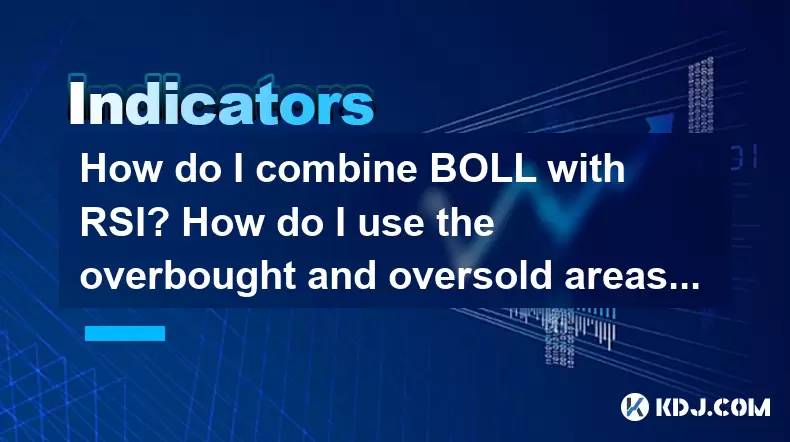-
 bitcoin
bitcoin $112195.049338 USD
2.42% -
 ethereum
ethereum $4124.915858 USD
2.81% -
 tether
tether $1.000570 USD
0.02% -
 xrp
xrp $2.861568 USD
2.25% -
 bnb
bnb $1000.346670 USD
3.04% -
 solana
solana $209.070819 USD
3.38% -
 usd-coin
usd-coin $0.999870 USD
0.02% -
 dogecoin
dogecoin $0.235379 USD
2.65% -
 tron
tron $0.335681 USD
-0.20% -
 cardano
cardano $0.803501 USD
3.38% -
 hyperliquid
hyperliquid $47.120881 USD
3.56% -
 chainlink
chainlink $21.501300 USD
3.44% -
 ethena-usde
ethena-usde $1.000571 USD
0.02% -
 avalanche
avalanche $29.793378 USD
3.62% -
 stellar
stellar $0.366964 USD
2.42%
How do I combine BOLL with RSI? How do I use the overbought and oversold areas together?
Combining BOLL and RSI helps traders identify overbought and oversold conditions, monitor volatility, and spot potential price reversals in the crypto market.
May 22, 2025 at 12:21 am

Introduction to BOLL and RSI
Combining technical indicators such as Bollinger Bands (BOLL) and Relative Strength Index (RSI) can enhance a trader's ability to make informed decisions in the cryptocurrency market. BOLL is a volatility indicator that consists of a moving average and two standard deviation bands above and below it. RSI, on the other hand, measures the speed and change of price movements to identify overbought or oversold conditions. When used together, these indicators can provide a more robust trading strategy.
Understanding Bollinger Bands (BOLL)
Bollinger Bands are a powerful tool for assessing the volatility and potential price direction of a cryptocurrency. The bands consist of three lines: the middle band, which is a simple moving average (SMA), and two outer bands that are typically set two standard deviations away from the SMA. The upper band represents the upper limit of the price range, while the lower band represents the lower limit.
When the price of a cryptocurrency touches or crosses the upper band, it might indicate that the asset is overbought. Conversely, if the price touches or crosses the lower band, it could suggest that the asset is oversold. The distance between the upper and lower bands also indicates the level of volatility; wider bands suggest higher volatility, while narrower bands indicate lower volatility.
Understanding Relative Strength Index (RSI)
Relative Strength Index (RSI) is a momentum oscillator that measures the speed and change of price movements. It oscillates between 0 and 100 and is typically used to identify overbought or oversold conditions. An RSI value above 70 is generally considered overbought, suggesting that the cryptocurrency might be due for a price correction. Conversely, an RSI value below 30 is considered oversold, indicating a potential price increase.
The RSI can also show divergence, which occurs when the price of the cryptocurrency moves in the opposite direction of the RSI. This can be a strong signal of a potential reversal in the price trend.
Combining BOLL and RSI
To effectively combine Bollinger Bands and RSI, traders can look for specific signals that align both indicators. Here’s how you can use these indicators together:
Identify Overbought and Oversold Conditions: When the price touches the upper Bollinger Band and the RSI is above 70, it can be a strong indication that the cryptocurrency is overbought. Conversely, if the price touches the lower Bollinger Band and the RSI is below 30, it suggests the cryptocurrency is oversold.
Look for Divergence: If the price of the cryptocurrency reaches a new high but the RSI fails to reach a new high, it could indicate a bearish divergence. Similarly, if the price hits a new low but the RSI does not, it might signal a bullish divergence. When these divergences occur near the Bollinger Bands, they can provide additional confirmation of potential price reversals.
Monitor Volatility: The width of the Bollinger Bands can help you gauge the market's volatility. Narrow bands suggest that a significant price movement might be imminent, which can be confirmed by the RSI moving into overbought or oversold territory.
Using Overbought and Oversold Areas Together
Using overbought and oversold areas from both BOLL and RSI together can help traders make more accurate entry and exit decisions. Here’s a step-by-step guide on how to use these areas effectively:
Identify the Overbought Zone: Look for instances where the price touches or crosses the upper Bollinger Band and the RSI is above 70. This suggests that the cryptocurrency might be due for a price correction. Traders might consider selling or shorting the cryptocurrency at this point.
Identify the Oversold Zone: Look for instances where the price touches or crosses the lower Bollinger Band and the RSI is below 30. This indicates that the cryptocurrency might be due for a price increase. Traders might consider buying or going long on the cryptocurrency at this point.
Confirm with Divergence: Always look for divergence between the price and the RSI to confirm potential reversals. If the price is at the upper Bollinger Band but the RSI is showing a bearish divergence, it strengthens the case for a potential downtrend. Similarly, if the price is at the lower Bollinger Band and the RSI shows a bullish divergence, it strengthens the case for an uptrend.
Monitor for Breakouts: Sometimes, the price can break out of the Bollinger Bands. If this happens while the RSI is in overbought or oversold territory, it can signal a strong continuation of the current trend. Traders should be cautious and consider additional factors before making trading decisions based on breakouts.
Practical Example of Combining BOLL and RSI
To illustrate how to combine BOLL and RSI, let’s consider a practical example using Bitcoin (BTC). Suppose the price of BTC touches the upper Bollinger Band and the RSI is at 75. This indicates that BTC is potentially overbought. If the RSI then shows a bearish divergence, it further confirms that a price correction might be imminent. A trader might decide to sell or short BTC at this point.
Conversely, if the price of BTC touches the lower Bollinger Band and the RSI is at 25, it suggests that BTC is oversold. If the RSI then shows a bullish divergence, it strengthens the case for a potential price increase. A trader might decide to buy or go long on BTC at this point.
Setting Up BOLL and RSI on Your Trading Platform
To set up and use Bollinger Bands and RSI on your trading platform, follow these steps:
Open Your Trading Platform: Ensure you are logged into your trading platform that supports technical analysis tools.
Add Bollinger Bands:
- Navigate to the indicators menu.
- Search for 'Bollinger Bands' or 'BOLL'.
- Select the default settings (usually a 20-period SMA with two standard deviations).
- Apply the indicator to your chart.
Add RSI:
- Navigate to the indicators menu.
- Search for 'Relative Strength Index' or 'RSI'.
- Select the default settings (usually a 14-period RSI).
- Apply the indicator to your chart.
Analyze the Indicators: Observe how the price interacts with the Bollinger Bands and the RSI readings. Look for overbought and oversold conditions, divergences, and volatility changes to make informed trading decisions.
Frequently Asked Questions
Q1: Can Bollinger Bands and RSI be used for all cryptocurrencies?A1: Yes, Bollinger Bands and RSI can be applied to any cryptocurrency that has sufficient trading volume and price data. However, the effectiveness of these indicators may vary depending on the specific cryptocurrency's market dynamics.
Q2: How often should I check the Bollinger Bands and RSI indicators?A2: The frequency of checking these indicators depends on your trading strategy. For short-term trading, you might check them multiple times a day, while for long-term investing, weekly or even monthly checks could be sufficient.
Q3: Are there any other indicators that work well with Bollinger Bands and RSI?A3: Yes, other indicators that can complement Bollinger Bands and RSI include the Moving Average Convergence Divergence (MACD), Stochastic Oscillator, and the Average True Range (ATR). These can provide additional insights into market trends and volatility.
Q4: How do I handle false signals when using Bollinger Bands and RSI?A4: False signals can be mitigated by using additional confirmation tools, such as trend lines, support and resistance levels, and volume analysis. It’s also important to practice risk management and not rely solely on one or two indicators for trading decisions.
Disclaimer:info@kdj.com
The information provided is not trading advice. kdj.com does not assume any responsibility for any investments made based on the information provided in this article. Cryptocurrencies are highly volatile and it is highly recommended that you invest with caution after thorough research!
If you believe that the content used on this website infringes your copyright, please contact us immediately (info@kdj.com) and we will delete it promptly.
- Bitcoin Strategy Buys: Holdings Exceed Expectations in 2025!
- 2025-09-30 02:25:15
- Mutuum Finance Presale Defies Market Volatility: A New Era for DeFi?
- 2025-09-30 00:45:13
- Floki Crypto: Analyst Signals Potential Pump Setup – Ready to Ride the Wave?
- 2025-09-30 00:45:13
- Hypurr Hysteria: NFTs, Floor Prices, and Hyperliquid's Wild Ride
- 2025-09-30 01:45:13
- Remittix: The Crypto World's Next XRP?
- 2025-09-30 00:50:01
- Whales, MAGACOIN, and Presale ROI: Riding the Crypto Wave
- 2025-09-30 00:50:01
Related knowledge

What is a tower bottom candlestick pattern? Does it have a high success rate?
Sep 22,2025 at 07:18am
Tower Bottom Candlestick Pattern Explained1. The tower bottom candlestick pattern is a reversal formation that typically appears at the end of a downt...

What is a black hole pattern in the MACD indicator? Is it a cause for concern?
Sep 21,2025 at 06:54pm
Bitcoin's Role in Decentralized Finance1. Bitcoin remains the cornerstone of decentralized finance, serving as a benchmark for value and security acro...

How can I use the psychological line (PSY) to determine market sentiment?
Sep 17,2025 at 02:19pm
Understanding the Psychological Line (PSY) in Cryptocurrency TradingThe Psychological Line, commonly referred to as PSY, is a momentum oscillator used...

How can I determine if a double top pattern has officially formed?
Sep 21,2025 at 03:18am
Understanding the Structure of a Double Top Pattern1. A double top pattern consists of two distinct peaks that reach approximately the same price leve...

What is the Golden Valley pattern on the moving average? Is it better than the Silver Valley pattern?
Sep 21,2025 at 02:54pm
Understanding the Golden Valley Pattern in Moving Averages1. The Golden Valley pattern is a technical formation observed in cryptocurrency price chart...

What does a death cross of the RSI in the strong zone (above 50) mean?
Sep 17,2025 at 10:54pm
Understanding the Death Cross in RSI Context1. The term 'death cross' is traditionally associated with moving averages, where a short-term average cro...

What is a tower bottom candlestick pattern? Does it have a high success rate?
Sep 22,2025 at 07:18am
Tower Bottom Candlestick Pattern Explained1. The tower bottom candlestick pattern is a reversal formation that typically appears at the end of a downt...

What is a black hole pattern in the MACD indicator? Is it a cause for concern?
Sep 21,2025 at 06:54pm
Bitcoin's Role in Decentralized Finance1. Bitcoin remains the cornerstone of decentralized finance, serving as a benchmark for value and security acro...

How can I use the psychological line (PSY) to determine market sentiment?
Sep 17,2025 at 02:19pm
Understanding the Psychological Line (PSY) in Cryptocurrency TradingThe Psychological Line, commonly referred to as PSY, is a momentum oscillator used...

How can I determine if a double top pattern has officially formed?
Sep 21,2025 at 03:18am
Understanding the Structure of a Double Top Pattern1. A double top pattern consists of two distinct peaks that reach approximately the same price leve...

What is the Golden Valley pattern on the moving average? Is it better than the Silver Valley pattern?
Sep 21,2025 at 02:54pm
Understanding the Golden Valley Pattern in Moving Averages1. The Golden Valley pattern is a technical formation observed in cryptocurrency price chart...

What does a death cross of the RSI in the strong zone (above 50) mean?
Sep 17,2025 at 10:54pm
Understanding the Death Cross in RSI Context1. The term 'death cross' is traditionally associated with moving averages, where a short-term average cro...
See all articles


























![[Pycoin] PI Coin -Shocking Listance of Pycoin?! 'Rebellion' This time ... Pay attention to #paikoin [Pycoin] PI Coin -Shocking Listance of Pycoin?! 'Rebellion' This time ... Pay attention to #paikoin](/uploads/2025/09/29/cryptocurrencies-news/videos/pycoin-pi-coin-shocking-listance-pycoin-rebellion-time-pay-attention-paikoin/68da82f23cec1_image_500_375.webp)















































